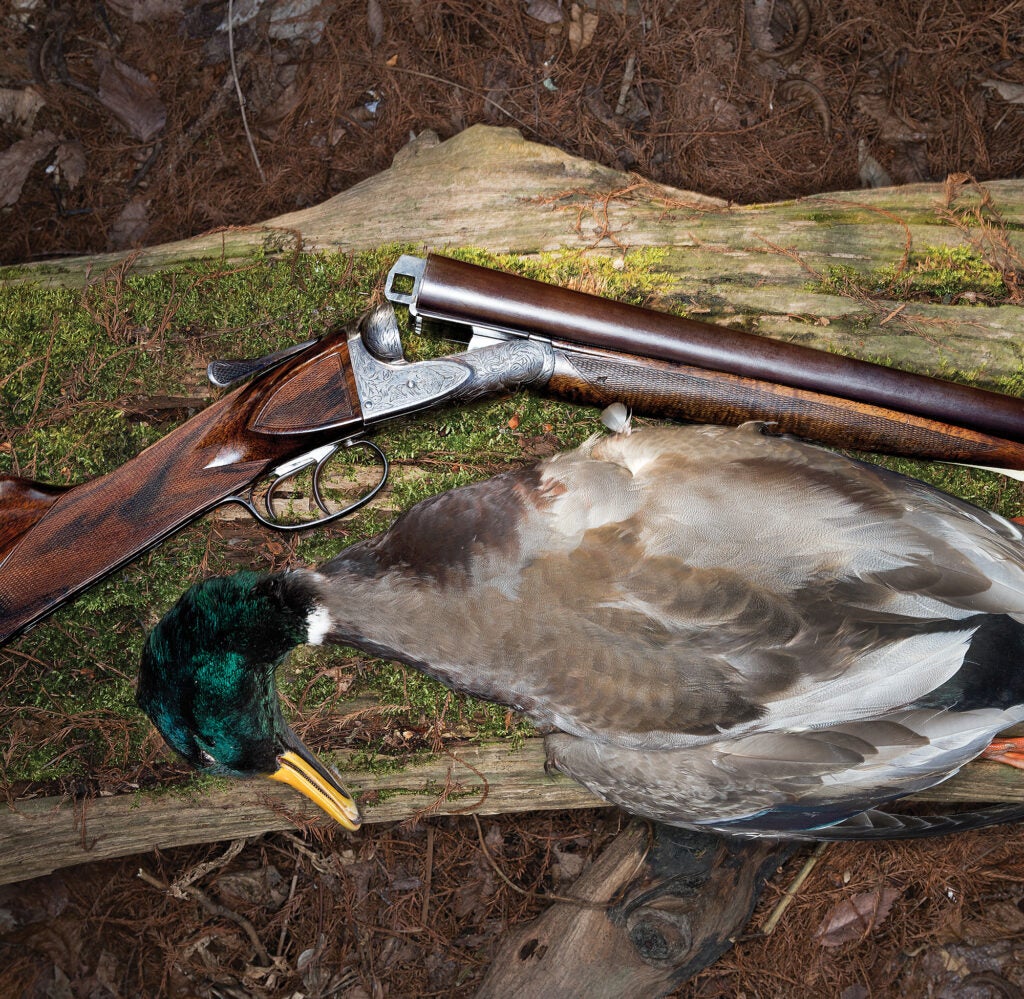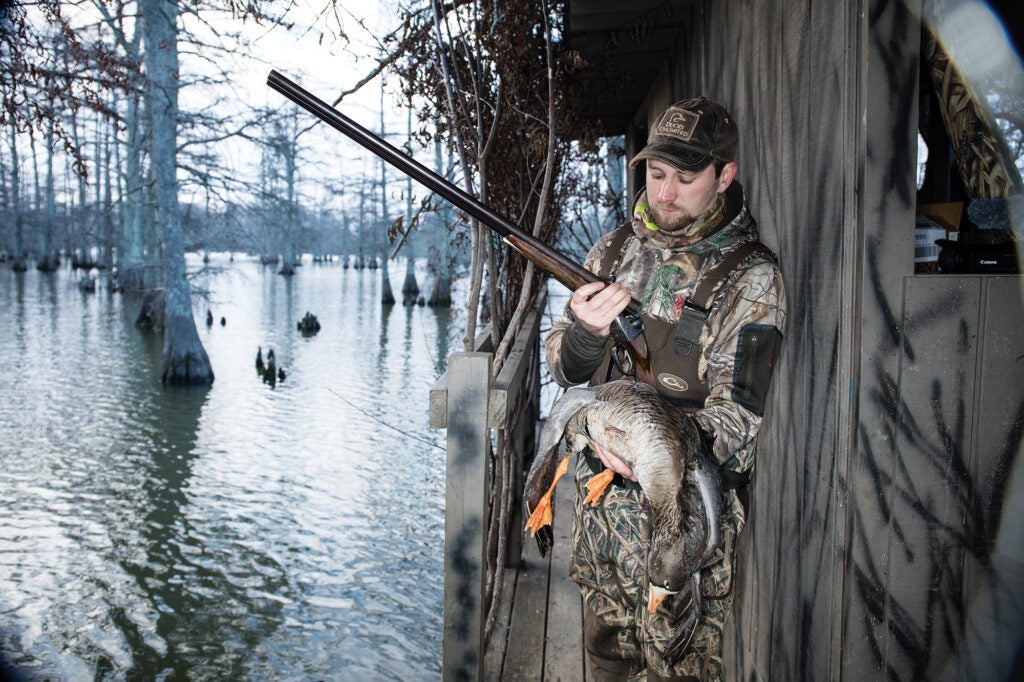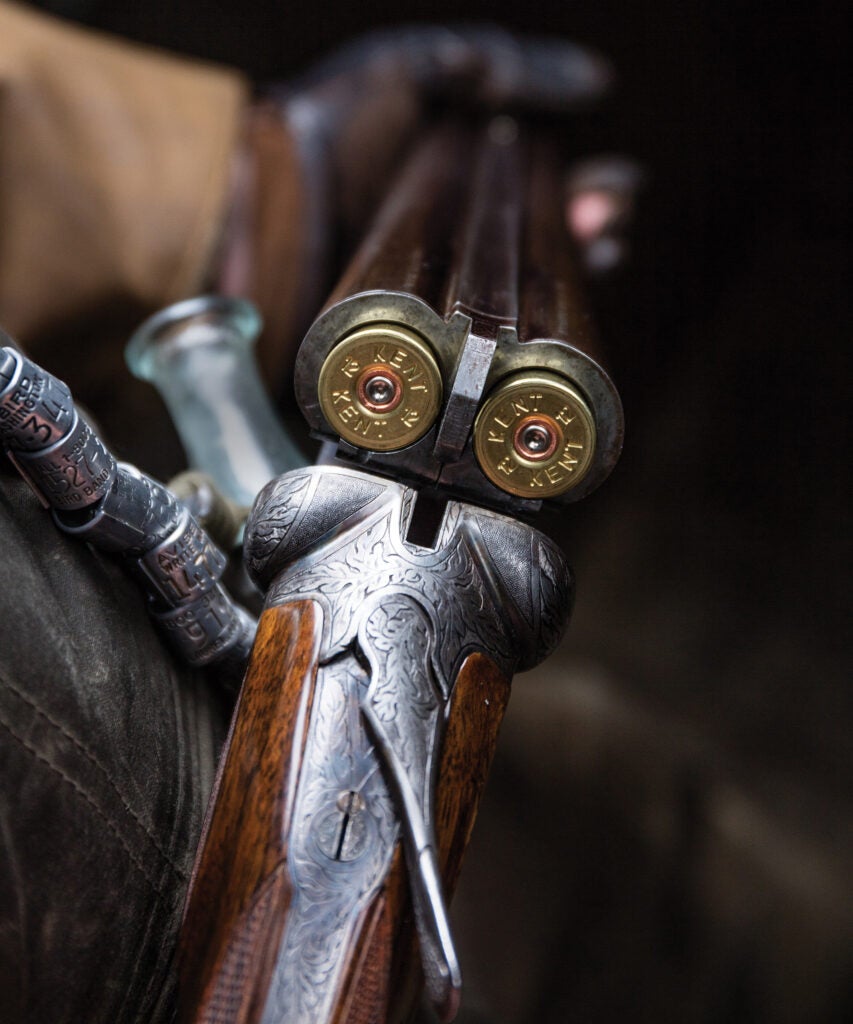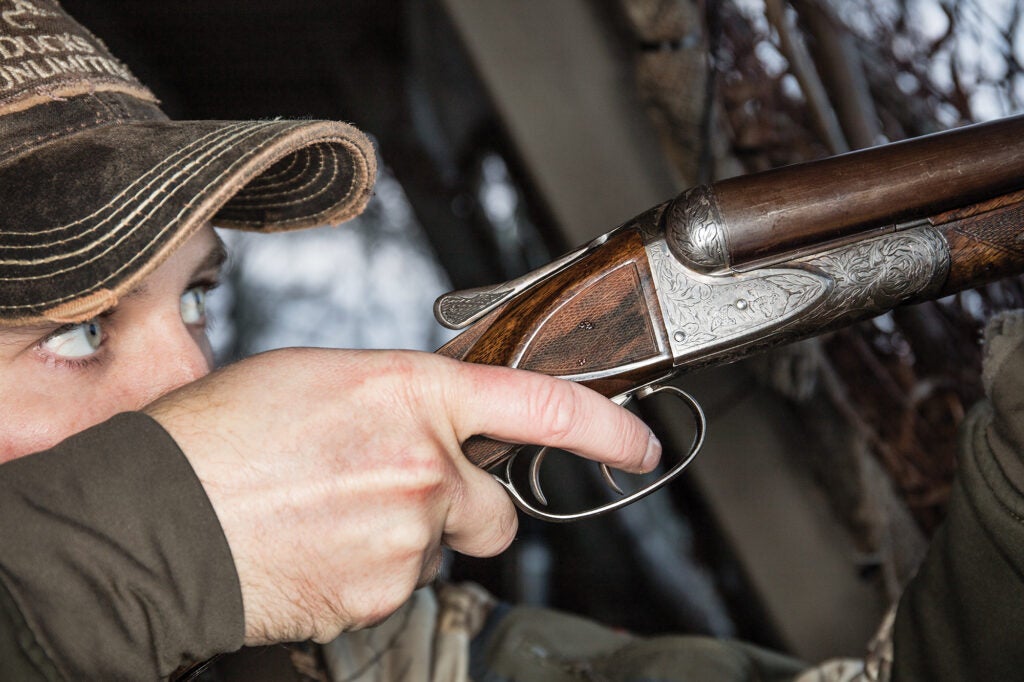The mallards catch us at midmorning, when our guts are growling and our guard is down. Typical of late-season ducks, the pair is within gun range before anyone notices them. Someone in the blind hisses “ducks” with the urgent tone that voids all gentlemen’s rules of calling the shot. I grab and shoulder the gun leaning up next to me. It’s not your typical duck gun. It’s a big double, a 90-year-old HE-grade Super Fox with stamped barrels. The right one reads MADE FOR NASH BUCKINGHAM; the left, BY BURT BECKER PHILA, PA. I pull the front trigger, and the gun’s report ripples through the green cypress and button willows. From here, it sounds like any other 12-gauge. But the guys at camp a quarter mile away later say they heard something different—a distinct, two-note report that they swear sounds just like it does in the legends: bo-whoop.

Lost and Found
Tunica County, Miss., has changed a lot since Nash Buckingham’s day. U.S. Highway 61 South long ago replaced the railroad and Limb Dodger as the primary mode of transportation for sportsmen traveling from Memphis to Tunica. The thickets full of quail are mostly gone, replaced by laser-leveled cotton and soybean fields. A strip of failing casinos sits on the banks of the Mississippi River, skeletons of promised economic progress in a region that consistently ranks among the country’s poorest. Yet, the iconic Blue and White Restaurant is still here. It still opens before sunup and it’s still where many duck hunters like to eat breakfast, just as Buckingham did. And if you jump in a boat and motor a few hundred yards into the cypress trees of Beaver Dam Lake, you’ll see a world that hasn’t changed since Buckingham’s day—a world the ducks still haunt every winter.
Most Southern duck hunters know something of Buckingham, arguably the most celebrated wingshooting writer in history. His adventures were immortalized in seven books—most famously De Shootinest Gent’man and Other Tales—and countless articles, including many in Field & Stream, where Buckingham was a regular contributor and, for a short stint, associate editor.
Yet, perhaps more famous than the man himself is his gun—the double-barrel Super Fox nicknamed Bo Whoop, due to the sound of its report at a distance. Bo Whoop was built by renowned gunsmith Burt Becker, choked Full and Full, and it was designed for the hot new duck load of the day, Western Cartridge Co.’s Super-X 3-inch load of No. 4 lead shot. With that shell, Bo Whoop reportedly produced a 90 percent pattern at 40 yards, and Buckingham’s ability to hit the “high birds,” as he described them, with the combo was legendary. Bo Whoop was a key character in many of his stories.

Then, in 1948, after a morning of hunting in Arkansas, Bo Whoop was lost. As the story goes, Buckingham and his friend Clifford Green were checked by a couple of game wardens, one of whom asked to see the famous “big gun.” Buckingham obliged, and at some point, the gun was set on the car fender. The hunters and officers then parted ways, and only after Buckingham and Green had driven a few miles down the road did they realize they’d left the gun on the fender. By the time they returned to get it, Bo Whoop was gone. Buckingham would never see his gun again.
The mystery of the gun’s disappearance only fueled its legend and bolstered Bo Whoop’s fame. Speculation and rumors surrounded its whereabouts for years. We do know that it was “found” in 2005, when an anonymous owner carried it into Darlington Gun Works in South Carolina to commission a replacement stock for the cracked original. The shop’s owner, Jim Kelly, recognized the gun for what it was and contacted a historian with A.H. Fox, who verified it. Kelly told the owner what he had, and offered $20,000 for the gun on the spot. The owner declined, and Kelly replaced the stock.
A few years later, the owner put the gun up for auction, and Bo Whoop was purchased for $201,250, including auction fees, by Hal Howard Jr., Buckingham’s godson. Howard then donated the gun to Ducks Unlimited, and it’s been on display at DU’s national headquarters in Memphis, Buckingham’s hometown, since 2010. The only better place for the gun to be is in a duck blind—which gave me an idea.
Last summer, I called a friend at DU and said what a story it would be if we took Bo Whoop back to Beaver Dam Lake for a hunt. After some discussion, the DU staff decided that’s just what Buckingham would’ve wanted.

Good to Go
Reality began to set in once we were planning the hunt: I’d be the first writer since Buckingham to shoot Bo Whoop since it was lost—and I’d be shooting on Buckingham’s home lake to boot. One night I had a dream that I dropped the gun—with a value higher than my house—into the mud. I felt more than a little pressure to kill a duck with it, too.
Before we actually hunted with Bo Whoop, the big gun’s condition had to be evaluated by a gunsmith. After all, Buckingham fired a lot of magnum loads through it; that, and the gun is 90 years old. The DU staff took it back to Jim Kelly, who inspected the gun and deemed it mechanically sound. Because the old lead load for which Bo Whoop was designed isn’t an option these days, we opted for a 23⁄4-inch, 11⁄4-ounce load of Kent Tungsten Matrix No. 5s, a safe alternative to steel shot in antique double guns.
With the gun no longer a safety concern, we got serious about the hunt. It would take place in late January, near the end of the 2015–16 Mississippi duck season. Mike and Lamar Boyd, the father-son staff of Beaver Dam Hunting Services (beaverdamducks.com), would be our hosts. Their primary blind is in the Clover Leaf Hole, a large brake in the ancient cypress trees that was referenced on occasion in Buckingham’s writings about Beaver Dam. DU’s Dale Hall, Steve Maritz, Rogers Hoyt, and Hunter Shepard would be hunting with me as well. Now we just needed cooperative ducks.

Deadly as Ever
The morning is mostly clear and cold with a stiff breeze. The gray ducks are stirring early, and within minutes of legal light, two of them set wings and drop into the decoys. Maritz shoulders Bo Whoop and knocks them both down. It’s fitting, not only because gadwalls are a staple duck in sleepy Southern cypress brakes, but because it’s a clean double. Buckingham wrote many things about Bo Whoop—but he rarely mentioned missing. Maritz passes the big gun to Hoyt, who doesn’t hold it long before three more gadwalls bomb the spread. He kills two of the birds with his first barrel, and he follows the third as it scrambles skyward. When the gadwall is about treetop high, the gun roars again and the third duck plops into the water.
“No misses in that gun!” Hoyt says.
He cracks the breech and hands the gun to me. I fish two shells from the open box and close the gun with a crisp click. Bo Whoop lacks a mechanical safety, a feature Buckingham rejected because, as he saw it, a safety bred carelessness. I can tell you that the lack of one agitates restless nerves. I hold the gun at low ready, barrels pointed outside the blind, waiting for my opportunity.
My first chance is at a white-fronted goose. Lamar works the bird for several passes before I finally take a high overhead shot, some 50 yards up. The goose wilts but keeps moving, so I fire the second barrel. The bird sails into the timber behind the blind and requires a couple of follow-up shots. It’s not the cleanest kill, but it’s a high bird with Bo Whoop, and a gorgeous speck at that. I pop the smoking hulls out of the gun—keepsakes—and admire the black barring on the goose’s chest. I sip coffee with trembling hands.
The gun is passed on to the next man. I’ve hunted with skilled shooters in every flyway, most of them armed with synthetic-stocked autoloaders. I don’t know that I’ve ever seen ducks killed with more efficiency than they are with Bo Whoop. Mike and Lamar each drop gadwalls with single barrels. Before long, we’re just duck hunting, taking turns shooting, laughing, and having a hell of a time. My anxiety over the $200K piece fades, replaced with the more familiar don’t-miss-in-front-of-your-buddies pressure.
Perhaps it’s that pressure that makes each of us concentrate all the more carefully on not missing. Perhaps we’re experiencing firsthand the capabilities of a custom-built piece from a bygone era of craftsmanship. Or perhaps the gun is magic. Regardless, I watch six men of different builds and experiences, men who’ve never before fired Bo Whoop at so much as a tin can, pick it up and mechanically drop one duck after another. No one gets too spiritual, but all of us are leaning toward magic.

Green Machine
Dale Hall, the CEO of DU, is adamant that everyone in the blind gets a bird with Bo Whoop before he picks it up himself. By late morning, he’s finally holding the gun but scanning empty skies. The hot flight has slowed to a trickle.
After two hours, Hall rests the big gun against a barrel rack in the Boyds’ blind and steps down into the boat hide for a quick break. That’s when the two mallards drop in. They’re 30 yards out when we see them, and when I shoulder the big gun, the drake is closer still, backpedaling and oblivious. A man could not ask for a more perfect duck, and I would rather not disappoint the ghost of Nash Buckingham by missing. I press the front trigger. Bo-whoop. The greenhead falls with a splash, an orange leg kicking. I have another barrel left, but I let the hen fly out without using it.
There’s little to explain, what with the smoking hull in one hand and dead greenhead in the other: I’ve just killed Hall’s duck. He only smiles and shakes my hand; there’s a light bloodstain around my thumbnail. “That is a beautiful bird,” Hall says.
Buckingham wrote a lot about good guns and great shooting, but a more frequent theme was good company. That we have good company here seems to make all the difference in our success. My duck heralds a flurry of late-morning mallards, and a few minutes later, Hall shoots a greenhead with Bo Whoop.

A Timeless Tool
As we glide through weaving aisles I calculate that I have dropped ducks on well nigh every square yard of this time-worn shooting ground. We have shared—still share—glorious years. The two of us are still hard at it. The reason? Because it has been left as it was. Because of sporting unselfishness and pride in its maintenance.—Nash Buckingham, “What Rarer Day,” Field & Stream, Nov. 1931
To a nonhunter, it might seem strange that a tool so notoriously lethal on ducks is so closely tied to one of the earliest advocates of waterfowl conservation. Buckingham told great stories, but more than that he used his platforms and voice to speak out against unregulated hunting and habitat destruction at a time when they presented a virtually unopposed threat to the resource. He’s owed no small credit for the conservation awakening of the early 1900s that led to such notable things as the Migratory Bird Hunting Stamp Act and the founding of DU.
Of course, what a shotgun can represent for conservation makes perfect sense to a duck hunter. Because of sporting unselfishness and pride in maintenance, there are still mallards to be found on Southern cypress brakes like those on Beaver Dam Lake—and, for that matter, healthy numbers of ducks to be hunted and enjoyed in every flyway. There are still friendships to be made in blinds. There are still a few great old guns around to help tell the stories of then and now.
This story was originally published in October 2016.
The post F&S Classics: Bo Whoop Comes Home appeared first on Field & Stream.
Articles may contain affiliate links which enable us to share in the revenue of any purchases made.
